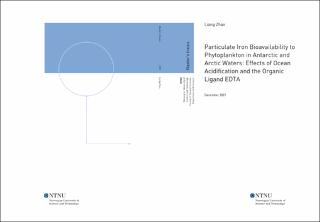| dc.description.abstract | Particulate iron (PFe) usually is not considered as a bioavailable iron fraction to phytoplankton. In this study we tested the bioavailability of one PFe species, goethite (α-FeO(OH)), to phytoplankton community in Southern Ocean under the effect of ocean acidification (OA) (pHT ca. 7.5) and representative concentration pathways (RCP) 8.5 condition (pCO2 ca. 1300 µatm), and to an Arctic diatom species, Nitzschia frigida, under the effect of the organic ligand, EDTA (using the commercially available salt disodium ethylenediaminetetraacetate dihydrate), as a chelator, respectively.
In March 2019, a natural phytoplankton community was sampled and used for the deck incubation experiment in the Southern Ocean. The sampling site was 68.10°S, 6.00° W, which was in the region of Queen Maud Land (Norwegian: Dronning Maud Land, DML). We observed marine biogeochemical performance of the phytoplankton community under OA. Different chemical and biological parameters during the incubation were determined, including dissolved iron (DFe), total acid leachable iron (TaLFe), macronutrients including nitrate (NO3-), phosphate (PO43-) and silicate, total pH (pHT), dissolved inorganic carbon (DIC), the concentration & fugacity of carbon dioxide (fCO2), chlorophyll a (Chla) concentration & in vivo fluorescence. The results show that the tested phytoplankton assemblage was more severely influenced by OA than iron bioavailability, especially under severe OA. Goethite, as one type of PFe, is insoluble under the tested OA scenarios. There could be PO43- remineralization in all treatments but species shift to diatoms only in ambient pH treatments (mild OA), which coincides with the judgement that OA impact is predominant in comparison to iron enrichment in this experiment. We should analyze phytoplankton species to test this hypothesis. OA can result in that phytoplankton launches Hv channel-mediated H+ efflux mechanism, carbon concentration mechanism (CCM) down-regulation of phytoplankton and the thriving of more tolerant species with more efficient CCM.
In April 2021, using an Arctic diatom species, Nitzschia frigida, we investigated the possibility of EDTA increasing goethite bioavailability to phytoplankton and photosynthetic performance by measuring relative electron transport rate (rETR) in the experiment performed at Trondheim Biological Station (Norwegian: Trondheim Biologiske Stasjon, TBS). The results show that elevating EDTA concentration can increase the bioavailability of goethite while decrease that of ferric chloride (FeCl3). This is inconclusive according to possibly negatively biased α (the slope of a typical P/E (photosynthesis/irradiance) curve), because it results in underestimation of goethite bioavailability under the influence of EDTA.
Further research regarding the combined effect of OA and EDTA on PFe bioavailability to phytoplankton is recommended.
Key words: iron bioavailability, goethite, phytoplankton, ocean acidification, EDTA. | |
